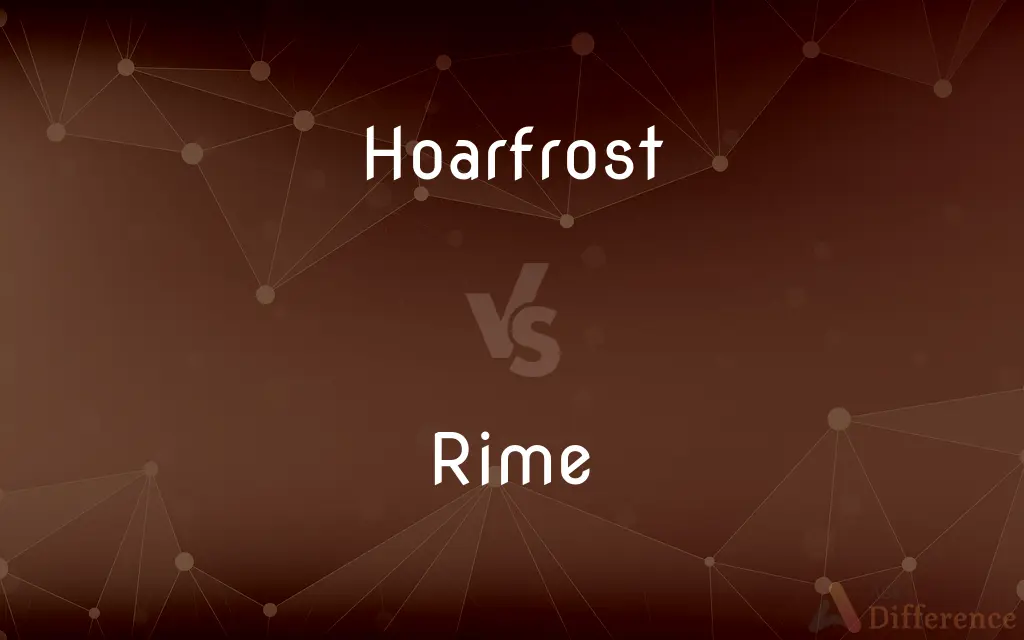Hoarfrost vs. Rime — What's the Difference?
By Urooj Arif & Fiza Rafique — Updated on April 6, 2024
Hoarfrost forms from water vapor in calm, cold conditions, creating feathery crystals, while rime forms on the windward side of surfaces from supercooled water droplets in fog, appearing hard and less delicate.

Difference Between Hoarfrost and Rime
Table of Contents
ADVERTISEMENT
Key Differences
Hoarfrost develops when water vapor in the air directly deposits as ice on surfaces, without first becoming dew, under clear, calm, and cold conditions. This direct deposition results in intricate, feathery ice crystals that typically cover ground and objects, creating a white, fuzzy appearance. Conversely, rime ice forms when supercooled water droplets in fog or low clouds freeze upon contact with objects that are at a temperature below freezing, leading to a more opaque, granular texture. Rime usually accumulates on the windward side of surfaces, indicating the direction of the cold wind.
The formation of hoarfrost is a delicate process that requires specific environmental conditions: clear skies, high humidity, and temperatures just below the freezing point. These conditions facilitate the sublimation of water vapor to ice, bypassing the liquid phase. Rime, on the other hand, forms in windy, foggy conditions with temperatures below freezing. The wind plays a crucial role in pushing supercooled droplets onto surfaces where they instantly freeze.
Aesthetically, hoarfrost is characterized by its delicate, feathery crystals that cling to surfaces, creating picturesque winter scenes. It often forms on tree branches, leaves, and grass, highlighting the intricate details of each surface it covers. Rime ice tends to have a rougher appearance, with ice forming in the direction of the wind, resulting in a less uniform and more granular coating that can make surfaces look encased in ice.
While both hoarfrost and rime ice can occur in cold weather, their distinct formation processes and appearances set them apart. Hoarfrost is more likely to form during calm, clear nights, especially in rural areas where surfaces cool rapidly. Rime ice, however, is more associated with foggy conditions and higher wind speeds, often occurring in mountainous regions where fog and cold air meet.
The impact of each on the environment and human activities also differs. Hoarfrost, with its light, feathery structure, is less likely to cause damage to vegetation or infrastructure. Rime ice, due to its density and the way it accumulates, can add significant weight to trees, power lines, and antennas, potentially leading to damage or power outages in severe cases.
ADVERTISEMENT
Comparison Chart
Formation Process
Direct deposition of water vapor as ice.
Freezing of supercooled water droplets on contact.
Conditions
Clear, calm, and cold with high humidity.
Foggy, windy, and below freezing temperature.
Appearance
Delicate, feathery crystals.
Opaque, granular, accumulates on the windward side.
Common Locations
Ground, vegetation, objects in open areas.
Windward sides of surfaces in foggy areas.
Environmental Impact
Minimal, mainly aesthetic.
Can cause damage due to weight on structures.
Compare with Definitions
Hoarfrost
A type of frost characterized by its delicate, intricate patterns.
Hoarfrost covered the windows, turning them into works of art.
Rime
A type of frost that forms on the windward side of objects, resulting from freezing supercooled water droplets.
The rime ice on the fence was thick from the dense fog last night.
Hoarfrost
Ice crystals that form on cold surfaces outside the direct presence of water.
The hoarfrost on the grass sparkled in the morning sun.
Rime
Ice accumulation on surfaces exposed to foggy air and freezing temperatures.
The mountain peaks were covered in rime, giving them a mystical appearance.
Hoarfrost
A deposit of ice crystals formed by direct sublimation on objects, often seen in calm, cold conditions.
The trees were beautifully adorned with hoarfrost in the early morning.
Rime
Weather phenomenon associated with fog and freezing temperatures.
Rime is common in the winter, especially in areas prone to foggy conditions.
Hoarfrost
A phenomenon that occurs under clear, calm, and cold weather conditions.
A heavy hoarfrost had settled overnight, blanketing everything in white.
Rime
A hard, icy coating or deposit that forms in windy, cold conditions.
Rime had formed on the branches, making them look like they were encased in glass.
Hoarfrost
Feathery ice formed from water vapor in the air, creating a white coating.
The hoarfrost made the spider's web look like a piece of intricate lace.
Rime
The opaque, granular texture of ice formed from supercooled water droplets.
The rime on the wind turbine blades can affect their performance.
Hoarfrost
A white coating of ice crystals formed by sublimation of atmospheric water vapor on a surface.Also called white frost.
Rime
Frost formed on cold objects by the rapid freezing of water vapour in cloud or fog.
Hoarfrost
Alternative form of hoar frost
Rime
Archaic spelling of rhyme
Hoarfrost
The white particles formed by the congelation of dew; white frost.
He scattereth the hoarfrost like ashes.
Rime
Cover (an object) with hoar frost
He does not brush away the frost that rimes his beard
Hoarfrost
Ice crystals forming a white deposit (especially on objects outside)
Rime
Archaic spelling of rhyme
Rime
A white incrustation of ice formed when supercooled water droplets freeze almost instantly on contact with a solid surface.
Rime
A coating, as of mud or slime, likened to a frosty film
"A meal couldn't leave us feeling really full unless it laid down a rime of fat globules in our mouths and stomachs" (James Fallows).
Rime
Variant of rhyme.
Rime
To cover with or as if with frost or ice
"heavy [shoes] rimed with mud and cement ... from the building site" (Seamus Deane).
Rime
(meteorology) Ice formed by the rapid freezing of cold water droplets of fog on to a cold surface.
Rime
(meteorology) A coating or sheet of ice so formed.
Rime
A film or slimy coating.
Rime
Rhyme.
Samuel Taylor Coleridge wrote The Rime of the Ancient Mariner in the 18th century.
Rime
(linguistics) The second part of a syllable, from the vowel on, as opposed to the onset.
Rime
A step of a ladder; a rung.
Rime
(obsolete) A rent or long aperture; a chink, fissure, or crack.
Rime
To freeze or congeal into hoarfrost.
Rime
Obsolete form of rhyme#Verb
Rime
A rent or long aperture; a chink; a fissure; a crack.
Rime
White frost; hoarfrost; congealed dew or vapor.
The trees were now covered with rime.
Rime
A step or round of a ladder; a rung.
Rime
Rhyme. See Rhyme.
Rime
To freeze or congeal into hoarfrost.
Rime
To rhyme. See Rhyme.
Rime
Ice crystals forming a white deposit (especially on objects outside)
Rime
Correspondence in the sounds of two or more lines (especially final sounds)
Rime
Be similar in sound, especially with respect to the last syllable;
Hat and cat rhyme
Rime
Compose rhymes
Common Curiosities
How is rime ice different from hoarfrost?
Rime ice forms from supercooled water droplets freezing on contact with cold surfaces, usually in windy and foggy conditions, leading to a granular, opaque appearance.
Why is rime ice often found on mountain tops?
Mountain tops frequently encounter the necessary foggy, windy, and cold conditions for rime ice formation.
Can hoarfrost and rime occur at the same time?
While they require different conditions, overlapping environmental factors can occasionally lead to both phenomena appearing in close proximity.
Does hoarfrost cause damage like rime?
Hoarfrost is generally less damaging than rime due to its lighter, feathery structure and does not significantly add weight to structures.
What causes hoarfrost to form?
Hoarfrost forms through the direct deposition of water vapor as ice on cold surfaces, under specific conditions of high humidity and calm weather.
What role does wind play in the formation of rime ice?
Wind carries supercooled water droplets that freeze upon contact with objects, causing rime ice to accumulate on the windward side.
Is hoarfrost only a winter phenomenon?
While most common in winter, hoarfrost can occur anytime when the conditions of high humidity, clear skies, and temperatures just below freezing are met.
Can rime or hoarfrost form indoors?
These phenomena typically occur outdoors; however, rime can form on indoor surfaces in extremely cold environments, like industrial freezers, if exposed to moist air.
Why does rime appear white or opaque?
The structure of rime ice scatters light in all directions, giving it a white or opaque appearance.
Can we predict when hoarfrost will form?
Forecasting clear, calm nights with temperatures just below freezing and high humidity can indicate the potential for hoarfrost.
How can rime ice affect aviation?
Rime ice can form on aircraft surfaces, leading to increased weight and aerodynamic drag, potentially affecting flight safety.
Share Your Discovery

Previous Comparison
Label vs. Trademark
Next Comparison
Surprise vs. UnexpectedAuthor Spotlight
Written by
Urooj ArifUrooj is a skilled content writer at Ask Difference, known for her exceptional ability to simplify complex topics into engaging and informative content. With a passion for research and a flair for clear, concise writing, she consistently delivers articles that resonate with our diverse audience.
Co-written by
Fiza RafiqueFiza Rafique is a skilled content writer at AskDifference.com, where she meticulously refines and enhances written pieces. Drawing from her vast editorial expertise, Fiza ensures clarity, accuracy, and precision in every article. Passionate about language, she continually seeks to elevate the quality of content for readers worldwide.















































